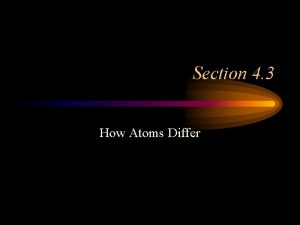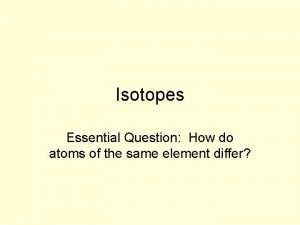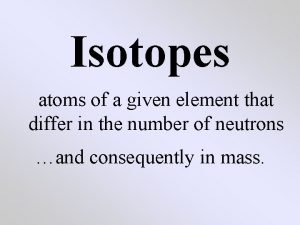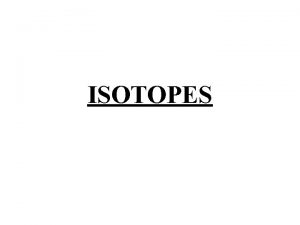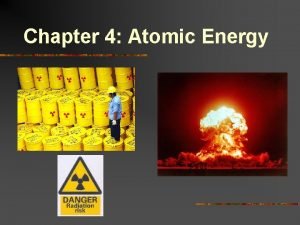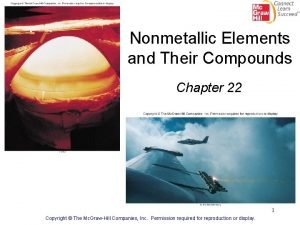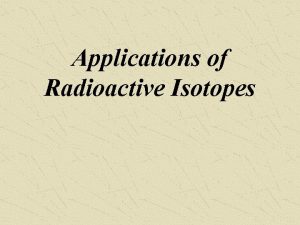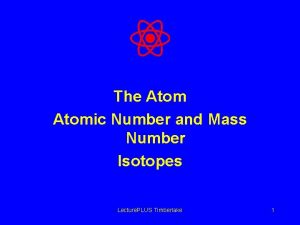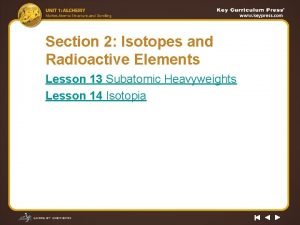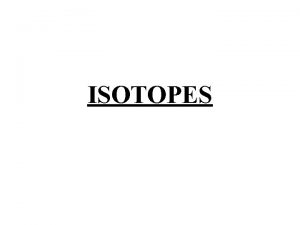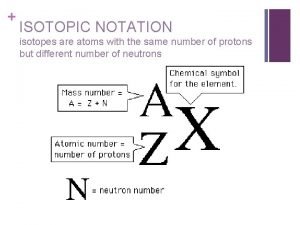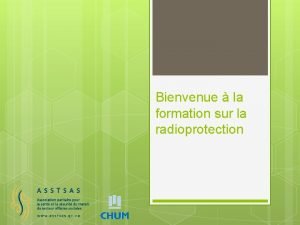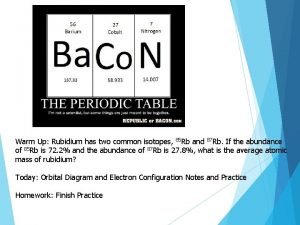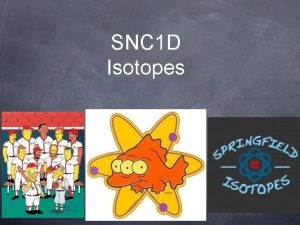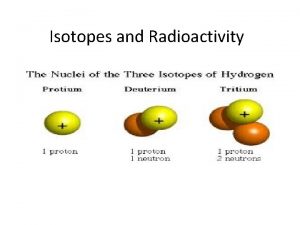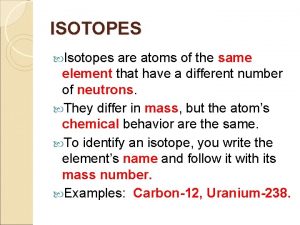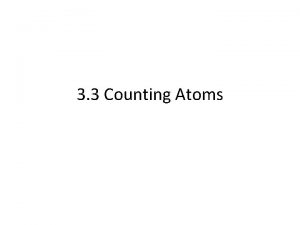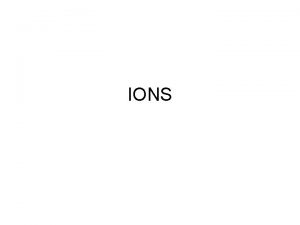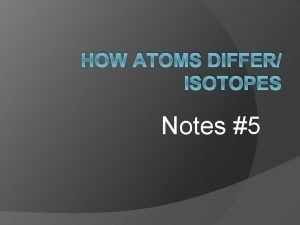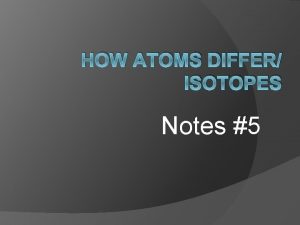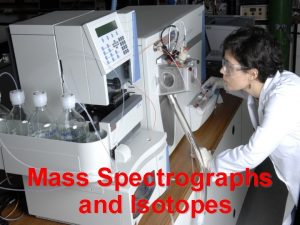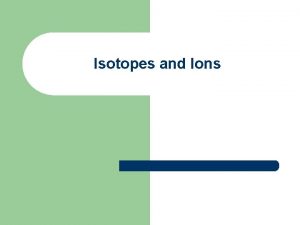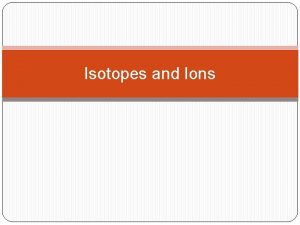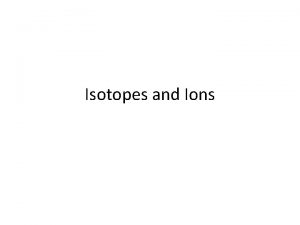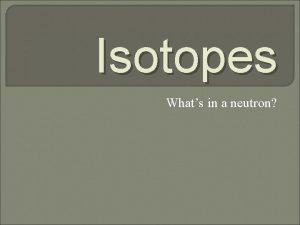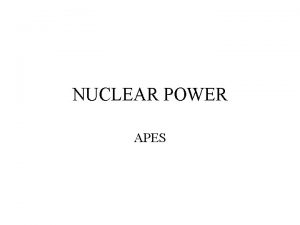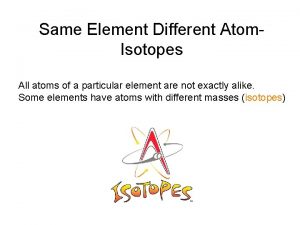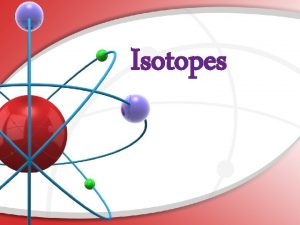Isotopes atoms of a given element that differ




























- Slides: 28

Isotopes atoms of a given element that differ in the number of neutrons …and consequently in mass.

Working with Atomic Notation A X z Atomic Mass (of Isotope) Atomic Number Chemical Symbol

Example #1 C 12 6 Atomic Mass (of Isotope) Atomic Number Chemical Symbol

Example #2 C 13 6 Atomic Mass (of Isotope) Atomic Number Chemical Symbol

Example #3 C 14 6 Atomic Mass (of Isotope) Atomic Number Chemical Symbol

Some isotopes of carbon 12 C 6 13 C 6 14 C 6

10 47 Ne Ag 20. 1797 107. 8682 3 11 Li Na 6. 941 22. 98977 Neon Lithium Silver Sodium

Various ways of identifying Isotopes • Using atomic notation, Example: 126 C or simply 12 C • Using the mass notation. Example: Carbon-12 or C-12 (read “carbon twelve” or “C twelve”)

Some Isotopes of Carbon mass notation atomic notation # of p+ # of e- C-11 11 C 6 6 C-12 12 C 6 6 C-13 13 C 6 6 C-14 14 C 6 6 # of no

Another example of isotopes 1 H 1 2 H 1 3 H 1 or H-1 H-2 H-3

The Isotopes of Hydrogen mass notation atomic notation # of p+ # of e- Hydrogen-1 1 H 1 1 Hydrogen-2 2 H 1 1 Hydrogen-3 3 H 1 1 # of no

Figure #1 Figure #2 Figure #3 p+ = no = e- =

Isotopes atoms of a given element that differ in the number of neutrons …and consequently in mass.

Why are masses on the periodic table usually expressed as decimal numbers? • masses on the table are weighted averages of all known isotopes of the element of interest

Keep in mind: §It is not possible to determine how many different isotopes exist by looking at the periodic table. §It is not possible to determine the frequency of various nuclides by looking at the periodic table.

The following does not occur in nature! 1 H 1 occurrence 33. 3% 2 H 1 occurrence 33. 3% 3 H 1 occurrence 33. 3%

The following does occur in nature! 1 H 1 occurrence 99. 98% 2 H 1 occurrence 0. 0156% 3 H 1 occurrence 0. 0044%

another way of looking at it: Imagine having 10, 000 H atoms 1 H 1 occurrence 9, 998 2 H 1 occurrence 1. 56 3 H 1 occurrence 0. 44

That means the weighted average is: 1 H 1 1 x 0. 9998 = 0. 9998 2 H 1 2 x 0. 00156 = 0. 00312 3 H 1 3 x 0. 00004 = 0. 00012 Weighted Average (0. 9998 + 0. 00312 + 0. 00012) 1. 01

Zn has 5 naturally occurring isotopes 30 Zn occurrence 30 Zn occurrence 64 66 67 68 70

Zn has 5 naturally occurring isotopes 30 Zn occurrence 49 % 30 Zn occurrence ~28 % 30 Zn occurrence ~4 % 30 Zn occurrence ~18 % 30 Zn occurrence ~1 % 64 66 67 68 70

Zn has 5 naturally occurring isotopes 64 30 Zn 49 % 66 30 Zn ~28 % 67 30 Zn ~4 % 68 30 Zn ~18 % 70 30 Zn ~1 % 65. 39

(parenthesis) on the Periodic Table indicate the most stable isotope stable means “longest living” Parenthesis also suggest the element of interest is radioactive.

Review problem #1 Represent the following using atomic notation. 92 U Uranium 238. 0289

Review problem #2 Represent the following using mass notation. 10 Ne Neon 20. 1797

Review problem #3 If the atom described below had 2 naturally occurring isotopes, which of the 2 would have a greater frequency of occurrence? Express your answer in atomic and mass notation. 3 Li Lithium 6. 941

Review problem #4 How many total subatomic particles are in the following “neutral” atoms of Fe-55 and Fe-57?

 Isotopes pogil
Isotopes pogil Atomic number mass
Atomic number mass Section 3 how atoms differ
Section 3 how atoms differ What does the atomic number represent
What does the atomic number represent Given the atomic notation of 64/30 zn
Given the atomic notation of 64/30 zn At stp which substance is the best conductor of electricity
At stp which substance is the best conductor of electricity Thơ thất ngôn tứ tuyệt đường luật
Thơ thất ngôn tứ tuyệt đường luật Tôn thất thuyết là ai
Tôn thất thuyết là ai Phân độ lown ngoại tâm thu
Phân độ lown ngoại tâm thu Walmart thất bại ở nhật
Walmart thất bại ở nhật Sau thất bại ở hồ điển triệt
Sau thất bại ở hồ điển triệt Gây tê cơ vuông thắt lưng
Gây tê cơ vuông thắt lưng Block xoang nhĩ là gì
Block xoang nhĩ là gì Tìm vết của mặt phẳng
Tìm vết của mặt phẳng Thơ thất ngôn tứ tuyệt đường luật
Thơ thất ngôn tứ tuyệt đường luật Hãy nói thật ít để làm được nhiều
Hãy nói thật ít để làm được nhiều Fertile isotopes
Fertile isotopes Isotopes examples
Isotopes examples Isotopes
Isotopes Hydrogen isotopes
Hydrogen isotopes Applications of radioisotopes
Applications of radioisotopes Examples of isotopes
Examples of isotopes Lesson 13 subatomic heavyweights isotopes
Lesson 13 subatomic heavyweights isotopes How to calculate average mass percent
How to calculate average mass percent Isotopes examples
Isotopes examples Isotopic notation
Isotopic notation Isotopes radioactifs
Isotopes radioactifs Rubidium has two common isotopes
Rubidium has two common isotopes Isotopes properties
Isotopes properties


